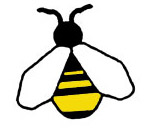
By Jane I. Sueme
Isabee’s Beekeeping Supplies
Nectar of the Gods, Sweetness and Light, Liquid Gold –
call it what you like, local honey is here!
When it comes to honey, what is local? For purposes of supporting the local food community, local can mean your neighborhood, town, regional or even national if it’s harvested and packaged within that area. Honey that is harvested in small batches, lightly filtered without pasteurization is local. Honey harvested by season, bee yard or hive and segregated by nectar source is both local and varietal. If you are looking for the beneficial health properties of honey, local is generally within a 25-mile range. Plant pollens from trees and native plants that contribute to seasonal allergies will be common within that given area.
By comparison, honey found on the typical American grocery shelf is packed by just a few national companies with honey imported from any number of foreign suppliers. As much as 80% of the commercial honey sold in the U.S. comes from China, India, Mexico, Argentina and Canada. Blended honey from multiple suppliers, packaged on a large scale results in a consistently colored and consistently tasting honey you find at the chain stores. Some of which is, as you may have read in the news, already modified or extended with other sweeteners before it reaches the United States.
Local is 100% Pure. Local beekeepers may lightly strain their honey to remove beeswax and other impurities, but do not apply heat high enough to kill bacteria or damage any of the micronutrients. Raw honey can range from lightly-filtered to a product of crushed honeycomb, forced through a course strainer, usually resulting in an opaque, waxy honey.
Look for seasonal differences in local honey, as indicated by color – spring honey is usually light, summer is amber, and fall nectar sources produce a darker honey. If the nectar sources are exclusively one plant within the honeybee forage range, than it is considered single source honey and can be identified by its source. Some common single source honeys in the U.S. are clover, basswood, tupelo, buckwheat and fireweed. As beekeepers and farmers work together to provide additional bee forage, we may see more singles source honey from our area… maybe lavender?
Where is the best place to find local honey? Support your local beekeepers by purchasing from local retailers, farmers markets, even seasonal craft and food events. If you are lucky enough to have a beekeeper in your neighborhood, you may be able to purchase from them directly. How fun would it be to meet the bees (or at least their keeper) that made your honey!
Is crystallized honey spoiled? All honey will crystallize over time. Crystallization is not fully understood or controlled – without applying heat, but we know it is not spoiled, merely converted from a liquid state to a solid. If your bottled honey crystallizes, you can reliquefy by warming it – either in a warm water bath, a sunny window, or even a hot car for a day. Enjoy!
For more information please contact Isabee’s Beekeeping Supplies at 314-894-8737 or visit online at www.isabees.com.


